Volume 11, Issue 1 (2023)
Health Educ Health Promot 2023, 11(1): 11-20 |
Back to browse issues page
Download citation:
BibTeX | RIS | EndNote | Medlars | ProCite | Reference Manager | RefWorks
Send citation to:



BibTeX | RIS | EndNote | Medlars | ProCite | Reference Manager | RefWorks
Send citation to:
Rosmaria R, Heryani N. Development of Digital-Based Learning Multimedia to Improve Students' Skills in Childbirth. Health Educ Health Promot 2023; 11 (1) :11-20
URL: http://hehp.modares.ac.ir/article-5-65651-en.html
URL: http://hehp.modares.ac.ir/article-5-65651-en.html
R. Rosmaria *1, N. Heryani1
1- Department of Midwifery, Health Polytechnic of Jambi, Jambi, Indonesia
Keywords: Childbirth [MeSH], Digital Technology [MeSH], Multimedia [MeSH], Learning [MeSH], Clinical Skills [MeSH]
Full-Text [PDF 1939 kb]
(734 Downloads)
| Abstract (HTML) (820 Views)
Table 7) Media expert assessment
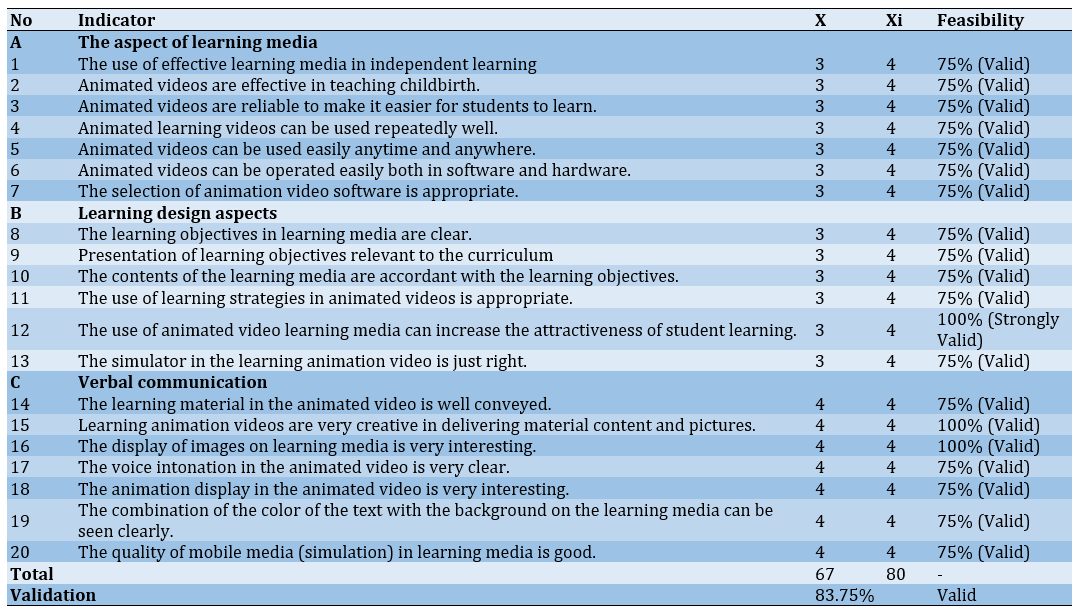
Table 8 shows the results of media experts validating the feasibility of animated video learning media. Animated video media is suitable for use as a learning medium to increase student knowledge.
• Material expert validation
The material expert's assessment of the material developed was 84%, which means that the material can be used validly but needs minor revisions so that the video is revised before using as a learning media (Table 9).
Table 10 shows material experts' results validating the feasibility of animated video learning media. It can be concluded that animated video media is suitable for use as a learning medium for childbirth courses because it meets the eligibility criteria.
Implementation and evaluation
• One-by-one evaluation
Based on the results of student assessments in the one-on-one group of 6 students, the proportion was 87.79%. Based on the results of student assessments, animated video learning media is included in the “Strongly valid and does not require revision” category. In this case, the researcher does not need to make revisions and can continue to the next stage.
• Small group evaluation
According to the student assessment in small groups involving 10 students, the proportion was 92.67%. Based on the results of student assessments, animated video learning media is included in the "very valid and does not require revision" category. In this case, the researcher does not need to make revisions and can continue to the next stage.
• Field evaluation
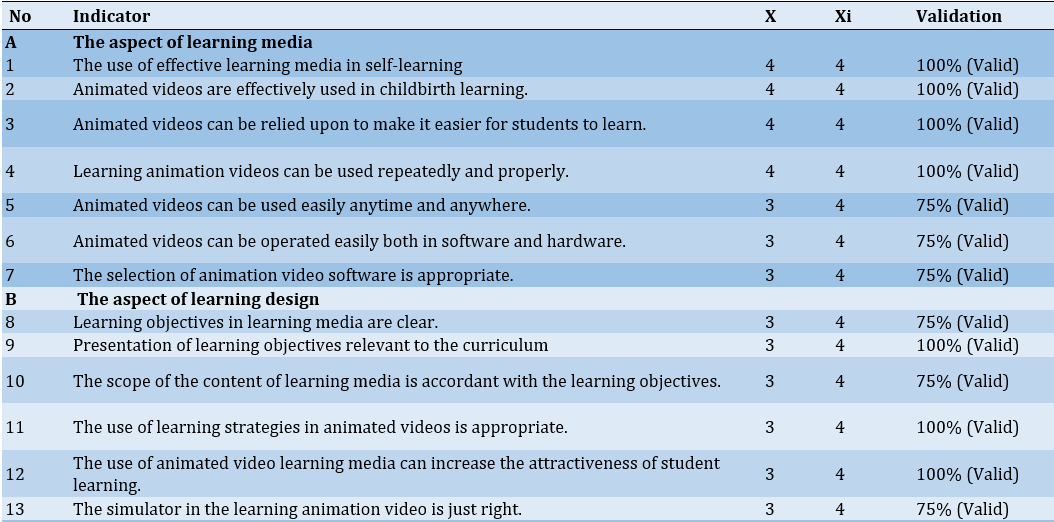
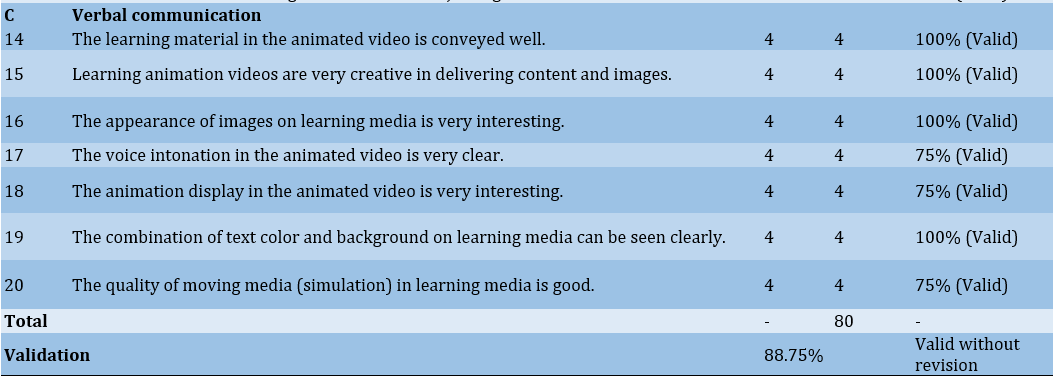
Table 9) Material expert assessment
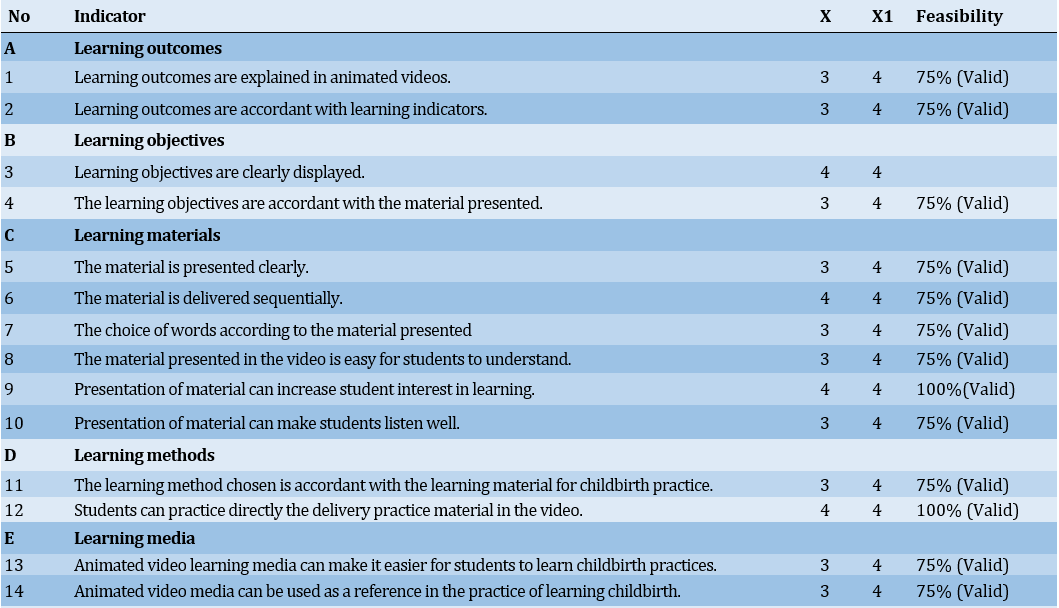

Table 10) The results of material expert revision

Full-Text: (126 Views)
Introduction
The rapid development of technology to date should be in line with the quality of human resources with the ability to utilize technology for the development of appropriate science and technology [1, 2]. In addition, advances in science and technology shape the character of students who are strong and sturdy to face the challenges of future life [3, 4].
Multimedia learning plays a major role in supporting the success of learning. In addition, multimedia learning can also stimulate the interest and motivation of students in learning. For this reason, through the right media it can affect the quality, process, and learning outcomes achieved by students [5, 6].
The learning process will bring benefits systematically, if the teacher is able to strengthen and modify various methods and techniques. These activities can be started from the design, development, media, utilization of various sources, implementation, and assessment of programs and learning outcomes. For this reason, the use of appropriate media in the learning process will greatly affect learning readiness [7, 8].
The learning process in midwifery is under the national midwifery education curriculum. One of the courses in midwifery education is the Maternity and Newborn Care course consisting of theory and practicum. In this course, students are expected to be able to perform physiological delivery assistance under delivery care standards [9]. Learning about childbirth is currently still using the traditional manual, mannequin media. This media has several drawbacks, one of which is not being able to visualize images or parts that are not visible, mainly for Vaginal Toucher (VT) examination [10].
Lately, the learning media that are often used are Zoom, e-learning, email, and WhatsApp. Media are various types of components in the environment of students that can stimulate them to learn to create more meaningful learning. The acquisition of learning outcomes will be better, if one of them is supported by the use of appropriate learning media [11].
In evaluation of the learning outcomes of childbirth courses, 45.3% of 101 students got a C grade, bringing them to take remedial to obtain a standard grade of the Aisyiyah School of Health, Jogjakarta [12]. According to the results of the national competency test for childbirth, 125 students did not pass the competency test [13]. Another problem was found in a study by Hilinti et al. [14], where the passing rate on the delivery care skills test was still low (36.6%). With these results, an effort is needed to improve student learning outcomes.
However, the implementation of learning media has not been relevant to the expected goals in the learning process. Therefore, it is very important to develop an appropriate media used in the learning process, especially for teaching childbirth courses. Learning will give better results if it is designed according to the way humans learn [15].
Currently, animated video multimedia has begun to be used in learning due to its features that can capture, record, process, transmit, and rearrange moving images [10]. Nowadays, Educators should utilize this media to deliver the mechanism of childbirth. The advantage of using multimedia videos and animations is to help students understand better learning topics. Through the use of video and animation media, students can carry out learning activities independently according to their respective speeds [9]. Infographic animations and an attractive display will help students to understand the material that tends to be difficult to understand [16]. Therefore, this study aimed to develop learning animation video media to improve students' skills in serving childbirth.
Materials and Methods
Study design
This study is a development research by designing and developing a learning media product to develop a detailed and integrated product. In this development research, the researcher used the ADDIE (Analyze, Design, Develop, Implement, and Evaluate) development model to produce video-based learning media that has gone through the validation, trial, and revision stages. The material in the media is about childbirth. The ADDIE development model starts from the analysis, design, development, implementation, and evaluation stages. This pattern of designing and developing ADDIE products is the most popular one because it has a traceable and systematic framework for organizing each series of research activities [17].
Setting of study
This development study was located at the Jambi Polytechnic Health Campus, Jambi province, Indonesia. Fifty-one participants were gathered in the campus hall and then divided into one small group of 6 participants, one large group of 10 participants, and one group of 35 participants who carried out field trial assessments.
Participants
The subjects in the study were 51 midwifery students in the fourth semester of the Jambi Health Polytechnic, which was held from January to November 2022. They were randomly selected with the criteria including being female and ability to use android. Meanwhile, students who were sick were excluded from the study.
Sample size
The sample size was determined using the Slovin formula [18]. The study population consisted of 59 people with precision value (d) = 0.05, and the total sample was 51 people.
Study procedure
This study developed an animated video and digital practicum instructions that can be used as learning media for childbirth courses. The research and development procedure consists of two main objectives, namely developing the product and testing the feasibility of the product. In other words, the main objective is referred to as the development function, while the second objective is referred to as the validation function.This study started by analyzing the problem of students' needs in learning to find out the problems experienced by the students and then looking for ideas or solutions to the problem with an intervention in the form of learning media products that can be used in the learning process of childbirth courses.
Development model
The development model for the application of Problem-Based Learning used in this study is a conceptual development method using the model introduced by ADDIE. According to Rusdi [17], the steps of the ADDIE framework start from the analysis stage, design stage, development stage, and evaluation. The stages in developing a learning model using the ADDIE framework describe in Figure 1.
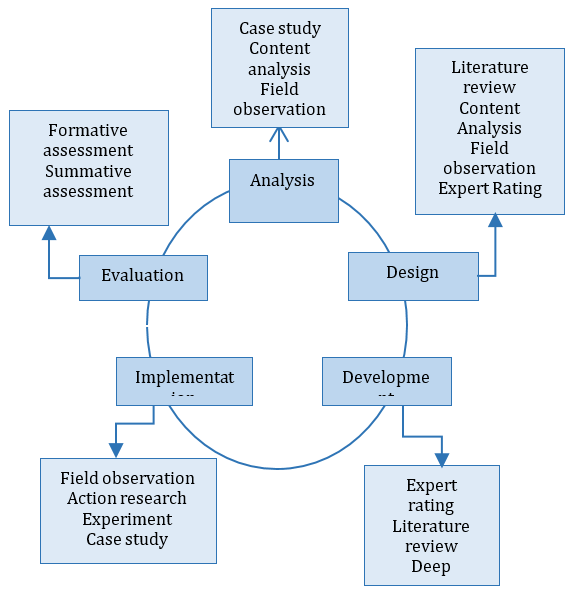
Figure 1) ADDIE framework steps
Data collection
Data were collected by distributing questionnaires to participants about childbirth learning and the media developed. Questionnaires were also created to test and obtain validation data from media and material experts. Questionnaires were given to validators to validate data about the characteristics of the learning media that had been developed (birth animation videos).
Direct interviews were conducted with the instructors regarding the development of the learning multimedia. The questions focused on childbirth learning in the classroom, learning resources and media used, and the obstacles faced by instructors in learning delivery.
Data analysis
The collected data were analyzed descriptively. To describe all opinions, suggestions, and responses, the validator used a 1-5 Linkert scale, with the highest score of 5 and the lowest score of 1. The next step was to determine the percentage of eligibility or validity criteria. The eligibility criteria or validation are seen in Table 1.
Table 1) Product feasibility assessment criteria

The assessment is declared valid if it meets the value scale >50.1 – 100 from the elements obtained from the questionnaire for media experts, material experts, and student responses. The assessment should meet the valid criteria; if it is not valid, then it will be revised until it reaches the valid criteria (Table 2).
Table 2) Product attractiveness evaluation criteria

Findings
Problem analysis
At this stage, the researcher observed the learning activities of the childbirth course directly in the midwifery department. Furthermore, the researchers compiled a questionnaire to find out what learning media is more appropriate to use in learning childbirth, including the difficulties or obstacles experienced in learning childbirth.
Based on the results of observations, the problems found in studying childbirth were the lack of student interest due to the limitations of interactive and interesting media. In addition, students feel bored with the media that is used monotonously, where students prefer media that can increase their passion and enthusiasm for learning, especially in learning childbirth. Table 3 shows the presence of problems faced by students related to the learning methods used by lecturers.
Table 3) Check list of problems analysis
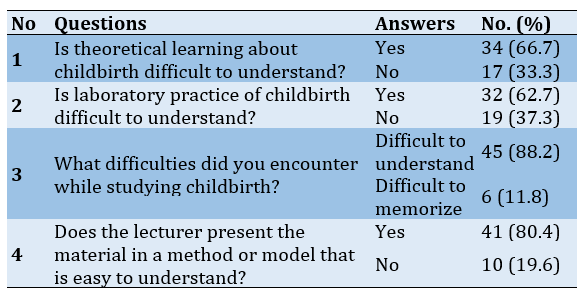
Needs analysis
The instruments used to conduct needs analysis were questionnaires and observation sheets to observe the implementation of learning in the classroom. Needs analysis data based on learning tools shows that the available media in the form of non-interactive media is less than optimal in conveying learning material. It is important to develop interactive learning media in the learning process. Based on the results of the needs analysis, there was a need for animated video learning media for childbirth services. Table 4 shows the high student need for animated videos as learning media, especially the theory and practice of childbirth.
Table 4) Check list of needs analysis

Analysis of student characteristics
The purpose of this analysis was to understand the various characteristics of students in learning activities, and the results of this analysis can be used as a guide in determining the appropriate media for students. The characteristics of students in the analysis included cognitive development and individual skills in carrying out childbirth practices under normal delivery care steps.
In addition, analysis activities are also carried out by observing the behavior and initial characteristics of students in learning so that they can determine learning media that are under student conditions. Table 5 shows that the learning atmosphere could have been more conducive when carrying out childbirth practices, and most students still needed help understanding the theory and practice of childbirth.
Tabel 5) Check list of analysis of student characteristics
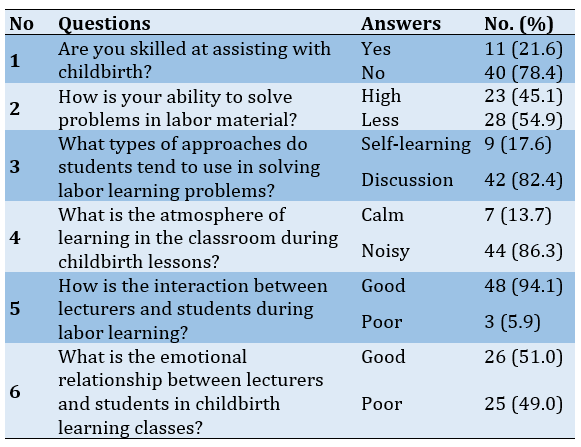
Video design
The process of making learning media was done by designing and conceptualizing learning media that will be developed, collecting material and making image designs, and designing material and images according to the descriptions that have been made. The main page of the animated video can be shown in Figure 2.
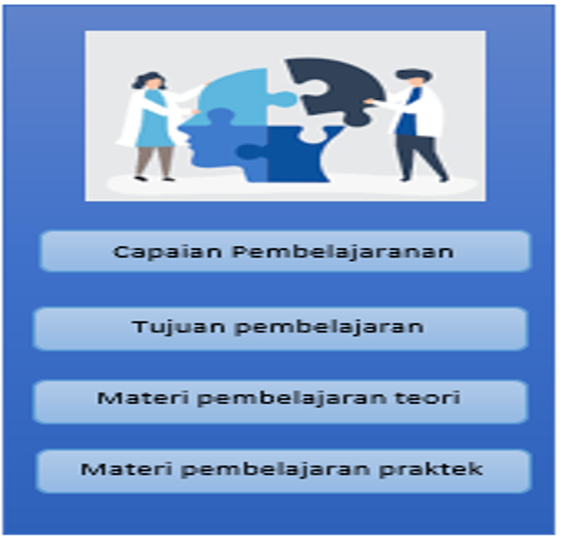
Figure 2) Main page
• Storyboard
The making of storyboards on development products must provide clear meaning and be following the wishes of the designer and developer. Besides that it must also be under the development objectives of the use of language, sound, and motion in animated videos following teaching materials to students.
• Determining product specifications
Products are developed according to the needs of students and contextually have specifications according to the needs of students in learning to provide messages based on the theory of learning, including pedagogical and non-pedagogical aspects.
• Making product prototypes
This developed product will be an example of a product that will be developed after the product is finished. Furthermore, this animated video still needs improvement in terms of technical aspect. Furthermore, it will be developed into a product that can be used as a learning medium.
Table 6 shows that students need learning media in the form of animated videos about childbirth.
Tabel 6) Check list of video animation needs

Development phase
• Expert team validation
The validity of the assessment in this study refers to the opinion of experts [19], which states that the validity of an instrument must be measured with a valid tool. The product development is in the form of an animated video validated by lecturers who are media experts to determine the feasibility and appropriateness of use for learning. Based on the eligibility criteria for animated video media, the score of 70.01 to 85 shows the media is valid and can be used but needs minor revision. The media expert's assessment of the developed media was 83.75%, which means that the media can be used but needs minor revisions (Table 7).
The rapid development of technology to date should be in line with the quality of human resources with the ability to utilize technology for the development of appropriate science and technology [1, 2]. In addition, advances in science and technology shape the character of students who are strong and sturdy to face the challenges of future life [3, 4].
Multimedia learning plays a major role in supporting the success of learning. In addition, multimedia learning can also stimulate the interest and motivation of students in learning. For this reason, through the right media it can affect the quality, process, and learning outcomes achieved by students [5, 6].
The learning process will bring benefits systematically, if the teacher is able to strengthen and modify various methods and techniques. These activities can be started from the design, development, media, utilization of various sources, implementation, and assessment of programs and learning outcomes. For this reason, the use of appropriate media in the learning process will greatly affect learning readiness [7, 8].
The learning process in midwifery is under the national midwifery education curriculum. One of the courses in midwifery education is the Maternity and Newborn Care course consisting of theory and practicum. In this course, students are expected to be able to perform physiological delivery assistance under delivery care standards [9]. Learning about childbirth is currently still using the traditional manual, mannequin media. This media has several drawbacks, one of which is not being able to visualize images or parts that are not visible, mainly for Vaginal Toucher (VT) examination [10].
Lately, the learning media that are often used are Zoom, e-learning, email, and WhatsApp. Media are various types of components in the environment of students that can stimulate them to learn to create more meaningful learning. The acquisition of learning outcomes will be better, if one of them is supported by the use of appropriate learning media [11].
In evaluation of the learning outcomes of childbirth courses, 45.3% of 101 students got a C grade, bringing them to take remedial to obtain a standard grade of the Aisyiyah School of Health, Jogjakarta [12]. According to the results of the national competency test for childbirth, 125 students did not pass the competency test [13]. Another problem was found in a study by Hilinti et al. [14], where the passing rate on the delivery care skills test was still low (36.6%). With these results, an effort is needed to improve student learning outcomes.
However, the implementation of learning media has not been relevant to the expected goals in the learning process. Therefore, it is very important to develop an appropriate media used in the learning process, especially for teaching childbirth courses. Learning will give better results if it is designed according to the way humans learn [15].
Currently, animated video multimedia has begun to be used in learning due to its features that can capture, record, process, transmit, and rearrange moving images [10]. Nowadays, Educators should utilize this media to deliver the mechanism of childbirth. The advantage of using multimedia videos and animations is to help students understand better learning topics. Through the use of video and animation media, students can carry out learning activities independently according to their respective speeds [9]. Infographic animations and an attractive display will help students to understand the material that tends to be difficult to understand [16]. Therefore, this study aimed to develop learning animation video media to improve students' skills in serving childbirth.
Materials and Methods
Study design
This study is a development research by designing and developing a learning media product to develop a detailed and integrated product. In this development research, the researcher used the ADDIE (Analyze, Design, Develop, Implement, and Evaluate) development model to produce video-based learning media that has gone through the validation, trial, and revision stages. The material in the media is about childbirth. The ADDIE development model starts from the analysis, design, development, implementation, and evaluation stages. This pattern of designing and developing ADDIE products is the most popular one because it has a traceable and systematic framework for organizing each series of research activities [17].
Setting of study
This development study was located at the Jambi Polytechnic Health Campus, Jambi province, Indonesia. Fifty-one participants were gathered in the campus hall and then divided into one small group of 6 participants, one large group of 10 participants, and one group of 35 participants who carried out field trial assessments.
Participants
The subjects in the study were 51 midwifery students in the fourth semester of the Jambi Health Polytechnic, which was held from January to November 2022. They were randomly selected with the criteria including being female and ability to use android. Meanwhile, students who were sick were excluded from the study.
Sample size
The sample size was determined using the Slovin formula [18]. The study population consisted of 59 people with precision value (d) = 0.05, and the total sample was 51 people.
Study procedure
This study developed an animated video and digital practicum instructions that can be used as learning media for childbirth courses. The research and development procedure consists of two main objectives, namely developing the product and testing the feasibility of the product. In other words, the main objective is referred to as the development function, while the second objective is referred to as the validation function.This study started by analyzing the problem of students' needs in learning to find out the problems experienced by the students and then looking for ideas or solutions to the problem with an intervention in the form of learning media products that can be used in the learning process of childbirth courses.
Development model
The development model for the application of Problem-Based Learning used in this study is a conceptual development method using the model introduced by ADDIE. According to Rusdi [17], the steps of the ADDIE framework start from the analysis stage, design stage, development stage, and evaluation. The stages in developing a learning model using the ADDIE framework describe in Figure 1.

Figure 1) ADDIE framework steps
Data collection
Data were collected by distributing questionnaires to participants about childbirth learning and the media developed. Questionnaires were also created to test and obtain validation data from media and material experts. Questionnaires were given to validators to validate data about the characteristics of the learning media that had been developed (birth animation videos).
Direct interviews were conducted with the instructors regarding the development of the learning multimedia. The questions focused on childbirth learning in the classroom, learning resources and media used, and the obstacles faced by instructors in learning delivery.
Data analysis
The collected data were analyzed descriptively. To describe all opinions, suggestions, and responses, the validator used a 1-5 Linkert scale, with the highest score of 5 and the lowest score of 1. The next step was to determine the percentage of eligibility or validity criteria. The eligibility criteria or validation are seen in Table 1.
Table 1) Product feasibility assessment criteria

The assessment is declared valid if it meets the value scale >50.1 – 100 from the elements obtained from the questionnaire for media experts, material experts, and student responses. The assessment should meet the valid criteria; if it is not valid, then it will be revised until it reaches the valid criteria (Table 2).
Table 2) Product attractiveness evaluation criteria

Findings
Problem analysis
At this stage, the researcher observed the learning activities of the childbirth course directly in the midwifery department. Furthermore, the researchers compiled a questionnaire to find out what learning media is more appropriate to use in learning childbirth, including the difficulties or obstacles experienced in learning childbirth.
Based on the results of observations, the problems found in studying childbirth were the lack of student interest due to the limitations of interactive and interesting media. In addition, students feel bored with the media that is used monotonously, where students prefer media that can increase their passion and enthusiasm for learning, especially in learning childbirth. Table 3 shows the presence of problems faced by students related to the learning methods used by lecturers.
Table 3) Check list of problems analysis

Needs analysis
The instruments used to conduct needs analysis were questionnaires and observation sheets to observe the implementation of learning in the classroom. Needs analysis data based on learning tools shows that the available media in the form of non-interactive media is less than optimal in conveying learning material. It is important to develop interactive learning media in the learning process. Based on the results of the needs analysis, there was a need for animated video learning media for childbirth services. Table 4 shows the high student need for animated videos as learning media, especially the theory and practice of childbirth.
Table 4) Check list of needs analysis

Analysis of student characteristics
The purpose of this analysis was to understand the various characteristics of students in learning activities, and the results of this analysis can be used as a guide in determining the appropriate media for students. The characteristics of students in the analysis included cognitive development and individual skills in carrying out childbirth practices under normal delivery care steps.
In addition, analysis activities are also carried out by observing the behavior and initial characteristics of students in learning so that they can determine learning media that are under student conditions. Table 5 shows that the learning atmosphere could have been more conducive when carrying out childbirth practices, and most students still needed help understanding the theory and practice of childbirth.
Tabel 5) Check list of analysis of student characteristics

Video design
The process of making learning media was done by designing and conceptualizing learning media that will be developed, collecting material and making image designs, and designing material and images according to the descriptions that have been made. The main page of the animated video can be shown in Figure 2.

Figure 2) Main page
• Storyboard
The making of storyboards on development products must provide clear meaning and be following the wishes of the designer and developer. Besides that it must also be under the development objectives of the use of language, sound, and motion in animated videos following teaching materials to students.
• Determining product specifications
Products are developed according to the needs of students and contextually have specifications according to the needs of students in learning to provide messages based on the theory of learning, including pedagogical and non-pedagogical aspects.
• Making product prototypes
This developed product will be an example of a product that will be developed after the product is finished. Furthermore, this animated video still needs improvement in terms of technical aspect. Furthermore, it will be developed into a product that can be used as a learning medium.
Table 6 shows that students need learning media in the form of animated videos about childbirth.
Tabel 6) Check list of video animation needs

Development phase
• Expert team validation
The validity of the assessment in this study refers to the opinion of experts [19], which states that the validity of an instrument must be measured with a valid tool. The product development is in the form of an animated video validated by lecturers who are media experts to determine the feasibility and appropriateness of use for learning. Based on the eligibility criteria for animated video media, the score of 70.01 to 85 shows the media is valid and can be used but needs minor revision. The media expert's assessment of the developed media was 83.75%, which means that the media can be used but needs minor revisions (Table 7).
Table 7) Media expert assessment

Table 8 shows the results of media experts validating the feasibility of animated video learning media. Animated video media is suitable for use as a learning medium to increase student knowledge.
• Material expert validation
The material expert's assessment of the material developed was 84%, which means that the material can be used validly but needs minor revisions so that the video is revised before using as a learning media (Table 9).
Table 10 shows material experts' results validating the feasibility of animated video learning media. It can be concluded that animated video media is suitable for use as a learning medium for childbirth courses because it meets the eligibility criteria.
Implementation and evaluation
• One-by-one evaluation
Based on the results of student assessments in the one-on-one group of 6 students, the proportion was 87.79%. Based on the results of student assessments, animated video learning media is included in the “Strongly valid and does not require revision” category. In this case, the researcher does not need to make revisions and can continue to the next stage.
• Small group evaluation
According to the student assessment in small groups involving 10 students, the proportion was 92.67%. Based on the results of student assessments, animated video learning media is included in the "very valid and does not require revision" category. In this case, the researcher does not need to make revisions and can continue to the next stage.
• Field evaluation
1. Trial before using the product
The results of field trials on 35 students before using
animation video development products obtained 73.5%, with the assessment criteria less valid because they fall into the interval of 70.01% to 85.00%. The response and assessment of students before using animated videos were not satisfactory. From this data, the researchers took the initiative to develop and revise the product of animated video learning media in childbirth courses.
animation video development products obtained 73.5%, with the assessment criteria less valid because they fall into the interval of 70.01% to 85.00%. The response and assessment of students before using animated videos were not satisfactory. From this data, the researchers took the initiative to develop and revise the product of animated video learning media in childbirth courses.
2. Field trials after using the product
The results of data analysis of student responses to animated video learning media obtained 92.86%, with strongly valid assessment criteria because it entered the 85.01% to 100% interval. The response and assessment of students towards animated video learning media in childbirth subjects is very good so that it can help students in the learning process and make it easier for students to understand childbirth learning materials.
Table 8) The result of media expert revision


Table 9) Material expert assessment


Table 10) The results of material expert revision

Discussion
The development of animated video media for childbirth courses is carried out by the ADDIE model development procedure consisting of 5 main stages, including the product analysis stage to be developed, design, development, expert validation, and revision. The implementation consists of small-scale field trials and large-scale field trials, and the final product. The initial product development stage is carried out by reviewing the curriculum of midwifery students so that the learning video media that is made does not deviate from the learning objectives [17].
The initial product development stage of video media is adjusted to the video development guidelines, which are classified into three stages: 1) pre-production stage, 2) production stage, and 3) post-production. After completing the initial product development, the product is then tested for validity/feasibility by four judges consisting of material experts, media experts, and teachers of the subjects concerned. Furthermore, the media was revised and analyzed according to expert advice. After the media was declared feasible by the experts, then the media was tested on small-scale field trials and large-scale field trials.
The design development carried out on the learning animation video is closely related to the learning in the childbirth course by selecting the material to be designed on the learning media and analyzing the content and scope so that it is accordant with the planned learning objectives [20, 21].
The storyboard of animated video learning media has a display that contains a clear meaning accordant with the wishes of the designer and developer. On each display sheet, there are various kinds of communication languages, both written and virtual languages, and motion languages, thus, each language used always supports the message and teaching material to be conveyed so that the message design is very important, as stated in the storyboard. Making storyboards is very important in developing animated video media because it is very useful to ensure that the learning concept has been conveyed or not and ensure that the navigation system is accordant with the interaction design [17].
The product development is carried out through several stages of assessment or validation of media and material experts so that the product developed is valid to be used as a learning medium [22, 23].
Implementation and evaluation are a direct link between designers and users. The implementation stage starts with a one-on-one evaluation with 6 students, a small group evaluation with 10 students, and a large group with 35 students (field trial).
Small-scale field trials aim to find out the weaknesses and shortcomings of video media when used by students as media users for later revision. After the media was revised, a large-scale field trial was then carried out. The media feasibility test in a large-scale field trial was carried out using 35 students. A large-scale trial was carried out with the aim that video media could become a product that was suitable for use as a learning medium in the midwifery department.
During the field trial, the students looked enthusiastic and serious because learning using interactive multimedia was very interesting. It is indicated by the high average score of the attractiveness indicator of learning using interactive multimedia. The attractiveness of this media is accordant with the benefits of the media; namely, learning can be more interesting because of the clarity and coherence of messages, changing images, and the use of special effects, which can arouse curiosity, make students think so that learning becomes more interactive with the application of learning theory and accepted psychological principles in terms of student participation in providing opinions, feedback, and reinforcement [24–26].
The experts who participated in the evaluation of the tool indicated high levels of adequacy, which establishes that the tool was well designed with regard to the objective established. That is, it allowed measuring the acquisition of clinical skills in nursing students, which will affect the provision of quality care for the patient. Student learning outcomes increase after using animated videos and are able to increase learning motivation because of the interactive elements contained in animated videos.
Limitation of study
This research was carried out during the COVID-19 pandemic; therefore, participants only came from one educational institution, the Health Polytechnic of Jambi, so the results cannot be generalized to all midwifery students. In the future, it is necessary to conduct research in a wider area.
Conclusion
We have developed an animated video-based learning media using the ADDIE development model to help students improve their skills in childbirth assistance. This animated video is proven to enhance students' ability to carry out laboratory birth practices, which are assessed based on the assessment results before and after giving the animated video. The product can visually and dynamically convey a complex concept and easily attract students' attention.
Acknowledgements: We give our highest appreciation to the Director of the Jambi Health Polytechnic, who has facilitated the implementation of this study through permits to use the IT laboratory.
Ethical Permission: The study protocol matched the Declaration of Helsinki's ethical guidelines for clinical studies. This research has been approved by the Health Research Ethics Commission of the Health Polytechnic of the Jambi Ministry of Health with registration number: LB.02.06/2/257/2021.
Conflict of Interests: The authors declare no conflict of interests.
Authors’ Contribution: Rosmaria R (First Author), Introduction Writer/Main Researcher/Statistical Analyst/Discussion Writer (60%); Heryani N (Second Author), Methodologist/Discussion Writer (40%)
Funding: This research did not receive financial support.
The development of animated video media for childbirth courses is carried out by the ADDIE model development procedure consisting of 5 main stages, including the product analysis stage to be developed, design, development, expert validation, and revision. The implementation consists of small-scale field trials and large-scale field trials, and the final product. The initial product development stage is carried out by reviewing the curriculum of midwifery students so that the learning video media that is made does not deviate from the learning objectives [17].
The initial product development stage of video media is adjusted to the video development guidelines, which are classified into three stages: 1) pre-production stage, 2) production stage, and 3) post-production. After completing the initial product development, the product is then tested for validity/feasibility by four judges consisting of material experts, media experts, and teachers of the subjects concerned. Furthermore, the media was revised and analyzed according to expert advice. After the media was declared feasible by the experts, then the media was tested on small-scale field trials and large-scale field trials.
The design development carried out on the learning animation video is closely related to the learning in the childbirth course by selecting the material to be designed on the learning media and analyzing the content and scope so that it is accordant with the planned learning objectives [20, 21].
The storyboard of animated video learning media has a display that contains a clear meaning accordant with the wishes of the designer and developer. On each display sheet, there are various kinds of communication languages, both written and virtual languages, and motion languages, thus, each language used always supports the message and teaching material to be conveyed so that the message design is very important, as stated in the storyboard. Making storyboards is very important in developing animated video media because it is very useful to ensure that the learning concept has been conveyed or not and ensure that the navigation system is accordant with the interaction design [17].
The product development is carried out through several stages of assessment or validation of media and material experts so that the product developed is valid to be used as a learning medium [22, 23].
Implementation and evaluation are a direct link between designers and users. The implementation stage starts with a one-on-one evaluation with 6 students, a small group evaluation with 10 students, and a large group with 35 students (field trial).
Small-scale field trials aim to find out the weaknesses and shortcomings of video media when used by students as media users for later revision. After the media was revised, a large-scale field trial was then carried out. The media feasibility test in a large-scale field trial was carried out using 35 students. A large-scale trial was carried out with the aim that video media could become a product that was suitable for use as a learning medium in the midwifery department.
During the field trial, the students looked enthusiastic and serious because learning using interactive multimedia was very interesting. It is indicated by the high average score of the attractiveness indicator of learning using interactive multimedia. The attractiveness of this media is accordant with the benefits of the media; namely, learning can be more interesting because of the clarity and coherence of messages, changing images, and the use of special effects, which can arouse curiosity, make students think so that learning becomes more interactive with the application of learning theory and accepted psychological principles in terms of student participation in providing opinions, feedback, and reinforcement [24–26].
The experts who participated in the evaluation of the tool indicated high levels of adequacy, which establishes that the tool was well designed with regard to the objective established. That is, it allowed measuring the acquisition of clinical skills in nursing students, which will affect the provision of quality care for the patient. Student learning outcomes increase after using animated videos and are able to increase learning motivation because of the interactive elements contained in animated videos.
Limitation of study
This research was carried out during the COVID-19 pandemic; therefore, participants only came from one educational institution, the Health Polytechnic of Jambi, so the results cannot be generalized to all midwifery students. In the future, it is necessary to conduct research in a wider area.
Conclusion
We have developed an animated video-based learning media using the ADDIE development model to help students improve their skills in childbirth assistance. This animated video is proven to enhance students' ability to carry out laboratory birth practices, which are assessed based on the assessment results before and after giving the animated video. The product can visually and dynamically convey a complex concept and easily attract students' attention.
Acknowledgements: We give our highest appreciation to the Director of the Jambi Health Polytechnic, who has facilitated the implementation of this study through permits to use the IT laboratory.
Ethical Permission: The study protocol matched the Declaration of Helsinki's ethical guidelines for clinical studies. This research has been approved by the Health Research Ethics Commission of the Health Polytechnic of the Jambi Ministry of Health with registration number: LB.02.06/2/257/2021.
Conflict of Interests: The authors declare no conflict of interests.
Authors’ Contribution: Rosmaria R (First Author), Introduction Writer/Main Researcher/Statistical Analyst/Discussion Writer (60%); Heryani N (Second Author), Methodologist/Discussion Writer (40%)
Funding: This research did not receive financial support.
Article Type: Original Research |
Subject:
Family Health Education/Promotion
Received: 2022/10/27 | Accepted: 2023/01/19 | Published: 2023/02/4
Received: 2022/10/27 | Accepted: 2023/01/19 | Published: 2023/02/4
References
1. Agustiningsih A. Video sebagai alternatif media pembelajaran dalam rangka mendukung keberhasilan penerapan kurikulum 2013 di sekolah dasar. J Pendidikan. 2015;4(1):50-8. [Indonesian] [Link] [DOI:10.21070/pedagogia.v4i1.72]
2. Yudianto A. Penerapan video sebagai media pembelajaran. In: Seminar Nasional Pendidikan. Indonesia, Sukabumi: 2017, 09 Agustus. [Indonesian] [Link]
3. Shuldman M, Tajik M. The role of media/video production in non‐media disciplines: the case of health promotion. Learn Media Technol. 2010;35(3):357-62. [Link] [DOI:10.1080/17439884.2010.508991]
4. Ratnawati D, Kusuma WM, Setuju S, Nurtanto M, Widodo W. Development of job sheet lathe machining practice based on animation video as interactive learning media. J Phys Conf Ser. 2020;1573:12005. [Link] [DOI:10.1088/1742-6596/1573/1/012005]
5. Hobbs R. Non‐optimal uses of video in the classroom. Learn Media Technol. 2006;31(1):35-50. [Link] [DOI:10.1080/17439880500515457]
6. Mardiana A, Doewes M, Purnama SK. Development of learning media based on video tutorial on basketball based shooting techniques. J Educ Health Sport. 2019;9(5):298-303. [Link]
7. Kurniawati N. Creating low-cost animation video using online platform: a learning media user review. J Pendidikan Kedokteran Indonesia. 2020;9(1):26-31. [Indonesian] [Link] [DOI:10.22146/jpki.53166]
8. Kusmaryati P, Herawati N, Wuryandari AG. Pengembangan Media Pembelajaran Kesehatan Reproduksi Remaja pada Remaja Awal di SMPN 19 Kota Jambi. J Akademika Baiturrahim Jambi. 2022;11(1):49-54. [Indonesian] [Link] [DOI:10.36565/jab.v11i1.439]
9. Islahunnufus I, Wiryotinoyo M, Rusdi M. Pengembangan Media Audio Visual Pembelajaran Penatalaksanaan Asuhan Kebidanan Persalinan. J Tekno-pedagogi. 2012;2(1):40-7. [Indonesian] [Link]
10. Rahmat B, Darmiati D. Pengembangan Media Pembelajaran dengan Video Based Learning di Akademi Kebidanan Pelamonia. Lectura J Pendidikan. 2021;12(2):149-65. [Indonesian] [Link] [DOI:10.31849/lectura.v12i2.7268]
11. Kodiyah N, Herawati DD, Lestari BW, Husin F, Wirakusumah FF, Setiawati EP. Pengembangan Media Pembelajaran Praktikum untuk Meningkatkan Keterampilan Asuhan Persalinan. J Pendidikan dan Pelayanan Kebidanan Indonesia. 2015;2(3):58-66. [Indonesian] [Link] [DOI:10.24198/ijemc.v2i3.67]
12. Yulastini F, Widaryati W. Hubungan Motivasi Belajar dengan Prestasi Belajar Asuhan Kebidanan Persalinan Mahasiswa Semester IV Program Studi D III Kebidanan Stikes' Aisyiyah Yogyakarta Tahun Ajaran 2012/2013 [Dissertation]. Yogyakarta: STIKES'Aisyiyah Yogyakarta; 2013. [Indonesian] [Link]
13. Meilani L, Mufdlilah M. Hubungan Hasil Belajar Asuhan Kebidanan II dengan Kesiapan Menolong Persalinan Normal pada Mahasiswa Semester IV Program Studi D III Kebidanan di STIKES Jendral Achmad Yani Yogyakarta [Dissertation]. Yogyakarta: STIKES'Aisyiyah Yogyakarta; 2013. [Indonesian] [Link]
14. Hilinti Y, Budi P, Ahmad M. Modul Asuhan Persalinan Kala III dengan Metode Preceptorship terhadap Keterampilan Mahasiswa DIII Kebidanan. J Keperawatan Silampari. 2020;3(2):477-88. [Indonesian] [Link] [DOI:10.31539/jks.v3i2.1036]
15. Gunawan G, Harjono A, Imran I. Pengaruh Multimedia Interaktif dan Gaya Belajar Terhadap Penguasaan Konsep Kalor Siswa. J Pendidikan Fisika Indonesia. 2016;12(2):118-25. [Indonesian] [Link] [DOI:10.15294/jpfi.v12i2.5018]
16. Dewi FF, Handayani SL. Pengembangan Media Pembelajaran Video Animasi En-Alter Sources Berbasis Aplikasi Powtoon Materi Sumber Energi Alternatif Sekolah Dasar. J Basicedu. 2021;5(4):2530-40. [Indonesian] [Link] [DOI:10.31004/basicedu.v5i4.1229]
17. Rusdi M. Penelitian desain dan pengembangan kependidikan. Depok: PT. Raja Grafindo Persada; 2018. [Indonesian] [Link]
18. Viechtbauer W, Smits L, Kotz D, Budé L, Spigt M, Serroyen J, Crutzen R. A simple formula for the calculation of sample size in pilot studies. J Clin Epidemiol. 2015;68(11):1375-9. [Link] [DOI:10.1016/j.jclinepi.2015.04.014]
19. Penuel WR, Fishman BJ, Haugan Cheng B, Sabelli N. Organizing research and development at the intersection of learning, implementation, and design. Educ Res. 2011;40(7):331-7. [Link] [DOI:10.3102/0013189X11421826]
20. Ntlokonkulu ZB, Rala NM, Goon D Ter. Medium-fidelity simulation in clinical readiness: a phenomenological study of student midwives concerning teamwork. BMC Nurs. 2018;17:31. [Link] [DOI:10.1186/s12912-018-0303-1]
21. Brady S, Bogossian F, Gibbons K, Wells A, Lyon P, Bonney D, et al. A protocol for evaluating progressive levels of simulation fidelity in the development of technical skills, integrated performance and woman centred clinical assessment skills in undergraduate midwifery students. BMC Med Educ. 2013;13:72. [Link] [DOI:10.1186/1472-6920-13-72]
22. O'Connor S, Daly CS, MacArthur J, Borglin G, Booth RG. Podcasting in nursing and midwifery education: An integrative review. Nurse Educ Pract. 2020;47:102827. [Link] [DOI:10.1016/j.nepr.2020.102827]
23. Mills J, Yates K, Harrison H, Woods C, Chamberlain-Salaun J, Trueman S, et al. Using a community of inquiry framework to teach a nursing and midwifery research subject: An evaluative study. Nurse Educ Today. 2016;43:34-9. [Link] [DOI:10.1016/j.nedt.2016.04.016]
24. Wahyunita VD, Suzana V, Munadhiroh M. Penerapan Media Pembelajaran Video Berbasis Web Sebagai Sumber Belajar Pengisian Partograf. Qual J Kesehatan. 2020;14(1):11-8. [Indonesian] [Link] [DOI:10.36082/qjk.v14i1.94]
25. Winarni RS, Rasiban LM. Perception of japanese students in using online video as a learning media. Indonesian J Educ Res Technol. 2021;1(1):15-6. [Link] [DOI:10.17509/ijert.v1i1.32652]
26. Puspitarini YD, Akhyar M, Djono D. Developing powtoon-based video learning media for five grade students of elementary school. In: International Conference of Communication Science Research (ICCSR 2018). Atlantis Press; 2018. p. 173-7. [Link] [DOI:10.2991/iccsr-18.2018.37]
| Rights and permissions | |
 |
This work is licensed under a Creative Commons Attribution-NonCommercial 4.0 International License. |







